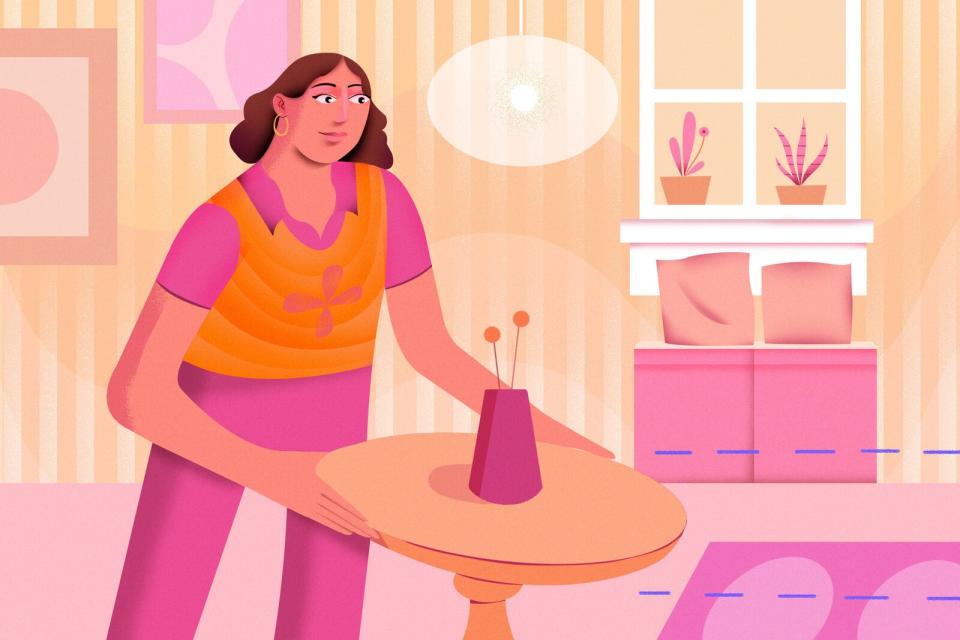"Puttering" Might Be Doing Nothing, But That’s Something
Also referred to as "piddling," carrying out low-stakes house chores allows us to reimagine spaces we’ve become sick of.

Welcome to The Trend Times, a column that explores design fads in the age of doomscrolling.
"What do you want to do when I get there?," my mom has inquired every time she’s set to come visit for the past 15 years.
I’m not sure why she still asks, as we both know what we’re going to spend at least one day doing. We love to "putter around"—"to spend time in a relaxed way doing small jobs and other things that are not very important," according to Merriam-Webster.
I don’t even remember life before puttering; as soon as I was capable I was copying my mother, spending Sundays zhuzhing my Beanie Baby collection. In college, we’d go to Bed Bath & Beyond and she’d help me figure out the ideal bathroom storage situation for my dorm room; a recurring favorite is going through my closet and getting rid of shit I don’t wear. The specific small home-making tasks we accomplish don’t really matter in hindsight; it’s the pure act of puttering that allows us to bond, unwind, and reimagine spaces we’ve become sick of.
I had never really heard anyone else talk about puttering, until I came across a sea of TikTok videos about "piddling"—what it’s called in the South. (No, in this context it does not mean peeing). It’s similarly described as a practice that’s passed down through generations, but unlike in my case, it often takes the wisdom of age to truly appreciate.
In this video, for example, Landon explains how his ideal day consists of "living his best life" by "doing a lot of things with a lackadaisical attitude." While he admits that piddling is different from lying down and resting, it also doesn’t quite fit into what we consider work: "We’ve all gotten to thinking we should be going going working working, when we really need a day to just piddle around."
The beauty of piddling or puttering is that it lives in the realm of "doing nothing," but it’s active; without leaving the house, you can still get dopamine from accomplishing tasks. It’s also preventative: when you carry out a bunch of small homemaking chores, you prevent the emergence of a large one. And, depending on the project, puttering can be a creative outlet that speaks to the interior design practice that "a good house is never done."
I also wonder if we don’t deem this activity as "not important" and "nothing" because it’s historically been done by women; it’s the invisible household labor that’s not acknowledged as real work. According to the recent book After Work: A History of the Home and the Fight for Free Time by Helen Hester and Nick Srnicek, before the industrial revolution of the early 20th century, running a home required a massive amount of labor from all members of the household. As necessary resources existed outside the home, the entire group had to tackle life-sustaining tasks like chopping wood, collecting coal, tending to kerosene lamps, bringing in water, and taking out waste. Even "free time" was spent making clothes.
You’d think the industrial revolution would have changed all that. Suddenly there was refrigeration, running water and gas, the mass production of flour and canned food. Surely, there’d now be a ton of leisure. But as the book explores, there wasn’t a massive reduction in hours spent on household duties over the course of the 20th century. "Prime-age adults spent twenty-six hours a week in 1900 on domestic work, while by 2005 that had only reduced to twenty-four hours a week." Technological advancements just meant certain members of the family (housewives) were now burdened with work that used to be divided, and expectations around cleanliness skyrocketed. We also own so many things now, and things require maintenance. Take laundry, for example, an activity I love to include in my puttering practice:
Laundering is perhaps the clearest example of incrementally increasing standards. If we go back to the 1800s, we find that most families rarely washed clothes – typically, only once every few weeks. Yet with the introduction of the domestic washing machine, the frequency of laundering shot up. By the 1960s, most families were washing clothes multiple times a week. By some accounts, Americans are now doing laundry almost three times more often than they did in the 1950s. Today, in countries such as Japan, it is common for people to do laundry every single day. Laundry has gone from being ‘a weekly nightmare to an unending task.’
It may seem like we will never escape the oppression of housework, but I find a meditative element to the practice of puttering that’s absent in other kinds of labor. While we face an onslaught of global tragedies, in addition to the personal ones, there’s therapeutic relief that comes with occupying your mind with little things in your space that you can control. There’s always been freaks that LOVE washing dishes, and during the pandemic, we saw a demonstrated rise in self-soothing through taking care of the home.
I imagine that to some people, a day of puttering sounds like a nightmare, but remember: you don’t even need to change out of your pajamas to do it. Just throw on a tavern wench cleaning playlist, grab a drink, and then go to town on what moves you. Some ideas: meditatively clean out the catch-all bowl by your front door, prune your houseplants, create new and exciting clusters, or decide a rug should be in a different room. I promise you it’s the most satisfying version of "doing nothing" you’ll ever do.
Related Reading:
